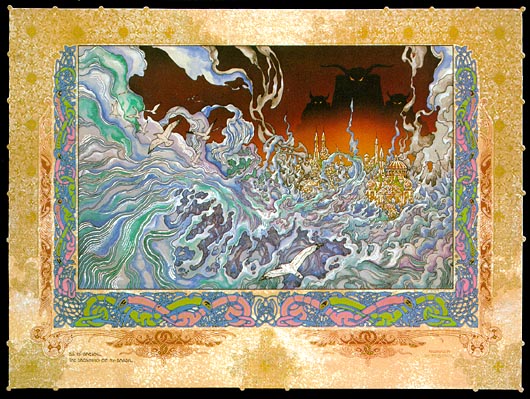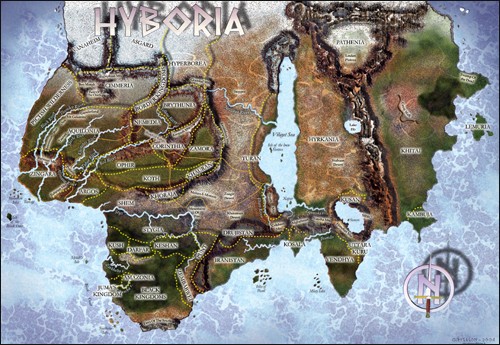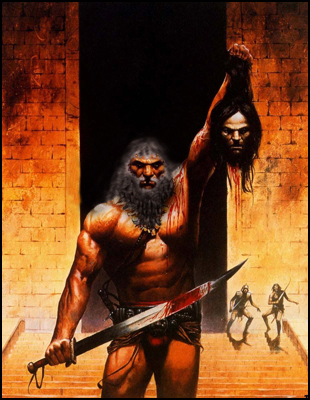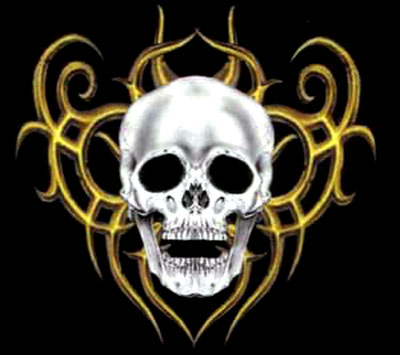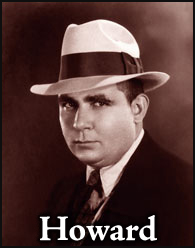
I recently ordered the magisterial collection The History of the Hobbit, a three-volume set available in slipcase. Those of us who treasure Christopher Tolkien’s The History of Middle Earth in twelve books have always lamented that, for various reasons, he failed to publish the same substantial analysis of The Hobbit that he undertook for The Silmarillion, The Lord of the Rings, and most of Tolkien’s other writings. Author John D. Rateliff has now rectified that oversight in spades.
Rateliff spent well over a decade analyzing the manuscripts for The Hobbit in a fashion that anyone familiar with Christopher Tolkien’s work will appreciate: sifting through drafts, dating manuscripts and typescripts, undoing many of the mistakes of earlier scholars, and offering a bewitching look into the creation of a modern classic. The set contains a great copy of the novel, complete with Tolkien’s original drawings, maps and color illustrations reproduced as plates on glossy paper stock, a pleasantly large font suitable for reading, and of course the latest corrected text. Two accompanying volumes, titled Mr. Baggins and Return to Bag-End, comprise Rateliff’s meticulous research, featuring not only a mountain of notes and other scholarship but Tolkien’s entire story in draft form, which gives us all sorts of strange and wonderful glimpses into a Hobbit that never was. When you get through the introduction and find out that Thorin began as a dwarf named Gandalf, it’s clear that you’ve dropped down a particularly beguiling rabbit (hobbit?) hole.
There is much here to inspire Howard fans. Might not our field someday get a History of the Hyborian Age, that charts the creation of REH’s body of fantasy work, reprints all the drafts, offers extensive commentary and notes, and contains an encyclopedia (or “glossography,” as Gary Gygax referred to the material underlying his Greyhawk campaign world) of all the people and places that make up the legendarium? Some of the work has been done, appearing in various journals and editions, but much remains for the enterprising scholar. I’ve always wished I had time to collate a Complete Guide to Hyboria the way Tolkien fans have Robert Foster’s Complete Guide to Middle-Earth. It’s volumes like these that go a long way towards captivating fans, and if one was written for REH I’m guessing it would vastly increase the respect for his world-building achievement.
Coming up in the October issue of TC (almost ready to ship) is a great letter from Steve Tompkins that speculates on various aspects of Aquilonian realpolitik, and reading that offers a small taste of the unexplored depths of Howard’s creation, namely how much realistic complexity those four years of brilliant story-writing generated. The usual know-nothings often assume that Howard gave little thought to realism and consistency — not true, as Tompkins amply shows in his letter. One of the most startling revelations Rateliff makes is that, far from Tolkien slowly composing his children’s story in languorous stretches of cautious composition, the manuscripts show that in all likelihood The Hobbit was written at white heat during vacation breaks from his teaching duties. This directly contradicts most of the favored images of Tolkien burning the midnight oil for leisurely years on end, and indeed sounds much more like the writing habits of a pulpster like REH than some would care to admit.
I have only begun exploring this spectacular effort on behalf of Tolkien scholarship, but already it has generated all sorts of thoughts about how REH scholarship could benefit from applying this Tolkienian example to our bailiwick.
